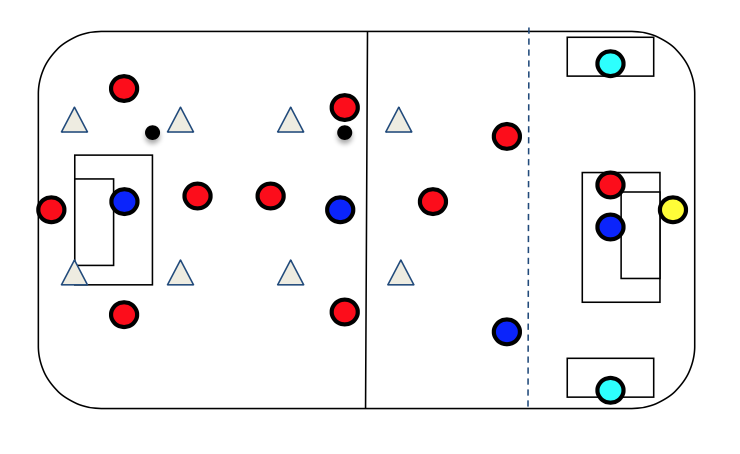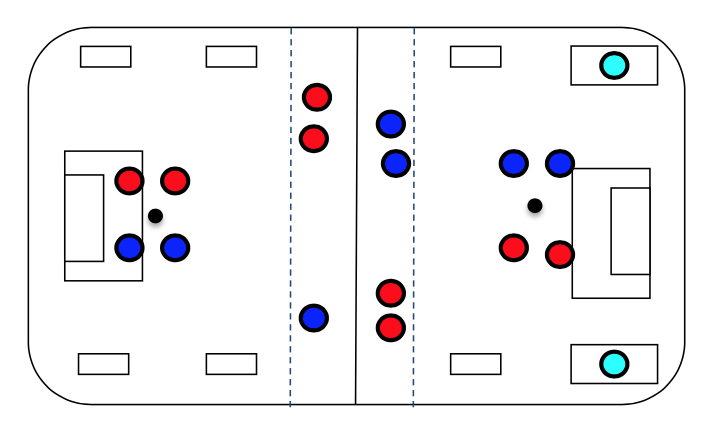We have concentrated on adults in this blog. All of our writers have, however, coached kids and teenagers as well and junior floorball is very close to our hearts. Here’s a short example about a complex training session for kids, in this case let’s say U10 juniors. Rink time 60 minutes.
Before the practice
We start the training session with a handshake / fist bump with all the players. We say “Hello” to each other and the coach tells key points about today’s session. After that we go to a circle, put our arms around each other and start with some positive words. Maybe we want to shout the team’s name together or something similar.
Goals: Create a positive and safe atmosphere from the start, togetherness, team routines
Warm up 20-30 minutes
Warm up consists of play and games.
1. “Everybody burns”
Equipment:
- 2-3 soft balls
- 20×20 meters zone (grass, concrete etc.)
Rules:
Everybody try to “burn” everyone in the zone. If you are hit with a ball, you get a “penalty” for 1 minutes and go outside the zone. You can get back inside sooner if the player who hit you with the ball is himself burned.
- You can’t move with the ball
- You don’t burn if the ball bounces from the floor
- You don’t burn if you get hit to the head
Variations:
- You only get back to the game if the player who burned you gets burned
- You don’t get back to the game, “Last man standing” (not the best option for a warm up)
- More balls
- During penalty, you do some simple physical exercise, for example 10 X-jumps
2. Different tag games
Simple tag game but with variations with the movement and / or what you do if you get caught
- Normal movement
- Move with one leg
- Move with “bear walk”
- Move with “crab walk”
When you get caught,
- “Bridge tag” – wait in plank position – you are saved if another player crawls under you
- “Squat tag” – wait in deep squat position – you are saved when another player gives you a high five
- etc.
Floorball session (60 minutes)
The goals of the session:
Skills:
With the ball:
- passing (with a purpose)
- Looking for space / scanning
- Pass if your teammate is in better position – dribble if not
Without the ball:
- offering passing options (support)
Team level:
- everybody attacks, everybody defends
- Communicate with your teammate
- Positive encouragement to try, fail and try again
Example group:
- 15 players with diverse skill levels + 2 goalies
1. a) 4v1 // b) 1v1+joker SSG (about 15 minutes if familiar, 20 if first time)
a) Two groups of five play 4v1 Possession game
Zone: 10×10 meters square marked with cones
Players: 5 (4 attackers, 1 defender)
Rules:
Four attackers are positioned at each side. They try to keep possession of the ball against a defender who can’t defend outside of the square. The four attackers should pass the ball always without rushing. If the defender intercepts the ball, the player who passed the ball goes inside.
Variations:
- set time as a defender – if the defender intercepts the ball, he gives it back to the attackers
- Set time as a defender – if the defender intercepts the ball, he tries to keep it while at the same time two attackers come to inside the circle and try to take the ball back
b) One group of five play 1v1+joker SSG with goalies
Zone: 20×6-8 meters, narrow playing field to encourage direct 1v1/2v1 challenges
Players: 5 (two teams of 2, 1 joker) + 2 goalies
Rules:
Play 1v1 (set shifts, 20-30 seconds) and a joker who is always on the side of the team that has the ball (numeral superiority). Encourage shooting to score to use that man advantage.
Variations:
- joker plays with the team that doesn’t have the ball (underload)

Picture: On the left side we play 2 x 4v1 possession game, on the right side 1v1+joker SSG with goalies
Every group of five plays two times 4v1 and once 1v1+joker SSG. Play about 4minutes, 1 minute break and change of place.
2. 2v2 to four goals (15 minutes)
Zone: 15×20 meters (x2, both ends of the field)
Players: 8+7 + 2 goalies (four teams of four*)
* one team of three
Rules:
Set up two playing fields where there is two goals at each end. Two goals can be big goals (goalies) and the other 6 should be small goals or if there’s not enough small goals, you can also use cones. Play 2v2 games, the team can score to either of the goals in their attacking end. The idea behind this game is to help the players to use the width of the playing field.
Play 30 second shifts, 3-4 minute games, count the score (if you want) but start every time from 0-0. Change the opponent after each game.

Picture: 2v2 to four goals, 2 separate games at both ends. If you don't have enough small goals, use cones.
3. 2v2 + 2v2 “The Cross game” (20-25 minutes)
Zone: 20×20 meters (half the field)
Players: 15 (four teams of four*) + goalies
* one team of three
Rules:
Play 2 simultaneous 2v2 games; one game is played vertically and one horizontally. Two big goals with goalies in one game, small goals in the other game. You must cross the (imaginery) midfield lane before you can score. The substitutes wait behind their own goal. 30 second shifts, 3 minute games and change the opponent. Key thing to ask players before the game – “What do you have to remember when there is two games played at the same time?” or “What should you do to avoid collisions?” (Answer usually comes quite fast).
There are couple of big ideas behind this game – first of all, it’s a fun game. Second, the players will self-organise and reduce their running speed almost automatically and start to scan their surroundings. Third, and this is more of a training structure thing – all the players are very active all the time. You can actually make 32 – even 40 players active this way if you use both ends of the field.
I like to play a small tournament in this cross game where we first play “a regular season” (2 points for win, 1 for draw) and after the regular season, we play the final and the bronze game.
Variations:
- use jokers

Picture: 2v2 + 2v2 The Cross Game. You can even play two 15-20 player Cross games simultaneously.
After the practice
We might want to do some cool down and / or mobility exercise after the training session if you find it useful. In any case, after the session, the coach can ask if we had fun, what was the key points of the session and after that, hands together and shout the teams name.
Few sidenotes
What I try to do with young kids sessions is to create a “street floorball” -like environment with simple games and lot of decision-making action. I sometimes might use 2-3 minutes to show some technical movements what they can try to do at home if they don’t have the possibility to play the game with friends. The goal is to make the sessions as fun and engaging as possible and the idea behind it is that the games would continue back home.
There’s also some words to be said about the team structure. It is preferable to keep the teams local as long as possible to encourage the playing outside the training sessions – play before the practice with friends, come with the same friends to the practice and then go back home to play again with the same friends. This dynamic is threatened if we start to create “elite teams” where players travel longer distance. It also usually takes the costs up which then reduces the possibilities to do multiple sports.
As many as possible, as long as possible.
Perttu Kytöhonka
